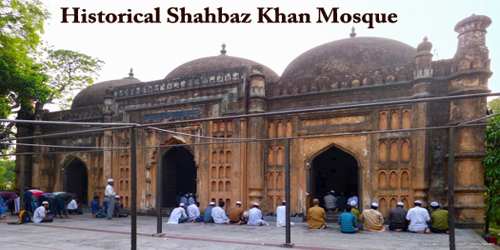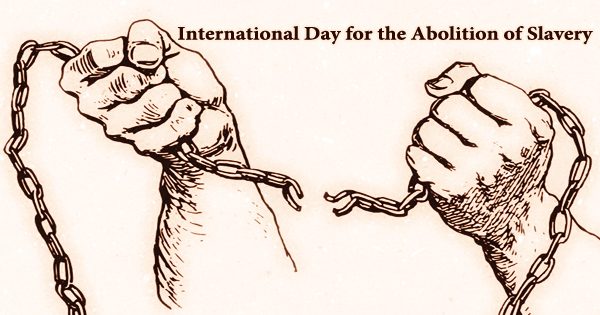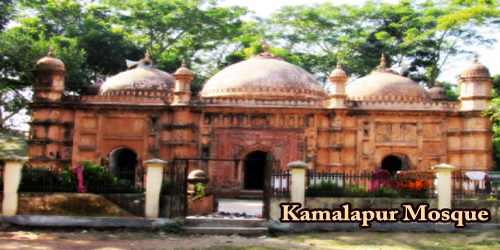In Bangladesh, Dhaka city has a specific identity of being called ‘the City of Mosques’. Shahbaz Khan Mosque is a historic mosque located in Dhaka, Bangladesh. A merchant of prince of Dhaka who built the mosque as well as his own Dargah Sharif during his lifetime in 1086 (h).It is Islamic architecture. Now its present condition is good. Shahbaz Khan Mosque situated in the old high court area. In 1950 the Eastern circle of the Pakistan Directorate of Archaeology (DOA) took over both the Haji Khwaja Shahbaz Masjid and the adjacent square Mazar. Shah baz khan built the Mazar and post. This mosque and tomb, constructed in 1679 by Haji Khwaja Shahbaz, a rich merchant of Dhaka, remains the city’s most refined mosque.
According to the book ‘Dhaka: Smriti Bismritir Nagari’ by the famous Bangladeshi writer, historian, and scholar Muntassir Mamoon, Haji Shahbaz Khan was an affluent merchant, who came to Bengal Subah (a subdivision of the Mughal Empire) from Kashmir and settled down in the area of Tongi. During his lifetime in 1679, he built this mosque and his own tomb. At that time, Prince Muhammad Azam was the viceroy of Bengal. But there is a controversy about the profession of Haji Shahbaz Khan, as many believe that he was a mason in the profession. Other than that it was obvious that he was a very pious man and familiar as a ‘Haji’ (successfully completed the Hajj to Mecca). He used to live in Tongi but often came to the mosque that he built himself, to preach Islam, as well as pray.
The mosque’s high fortified walls and occasional bastions were encroached upon, destruction, defacement of different structures and changes in internal spaces, had put the fort in a sorry state. The two-storied diwan block was partly damaged; bathhouse, niches were filled in, and decorative panels were mostly plastered over. The DOA accomplished a good job in restoring the structure and converting it into a museum in the first place, but the pinkish finish on the exterior, rather than the original lustrous white, fueled debates and controversies. The elegance of its interior bespeaks the patron’s wealth. The mosque’s interior is divided into three bays by two lateral cusped arches supported by stone piers embedded in the east and west walls. Yet the Directorate restored the do-Chala roof on the veranda at the south of the tomb and the decorative features like engaged corner turrets. This appears to be the first use of lateral cusped arches in a Bengali mosque’s interior and was doubtless inspired by imperial Mughal architecture. The central Mihrab, particularly noteworthy, is highly ornamented with Cyprus-filled kanjuras, ornate arabesque plastic relief in the spandrels, a cusped arch, and engaged colonettes standing on bulbous floral bases. Due east of the mosque is the small, square, single-domed tomb with engaged turrets at each corner. Attached to the Southside was a low rectangular chamber with a do-Chala roof, now collapsed. While the purpose of this room is not clear, it perhaps served as a prototype for the more symmetrical tomb of Khwaja Anwar-i Shahid in Burdwan. It reconstructed the brick podium and provided adequate provision for ablution, plumbing, and sanitation services. The front façade of the mosque has three arched openings within four slender columns. Historically in Mughal architecture, the standard architectural design was having two columns on the east façade of the mosque, but this mosque has four. It also has four corner turrets, ribbed and engaged. Earlier in it also has four corner turrets, ribbed and engaged. In a way, the other two mosques built slightly later than this one bear similar features but in an improved form. It is something that we now identify as a distinct Mughal style in Bengal. It also worked on other structures, too. It shied away from proper excavation and documentation of the intricate water supply system a network of terracotta pipes, an aqueduct, a water reservoir, and several fountains, until recently.
There are many fascinating facts about this old mosque. According to many, Haji Shahbaz used to come to this mosque with a large number of jinns and pray with them. On Fridays, during the Jumu’ah prayer, worshippers from different regions of the country, especially from old town areas come to pray at the mosque and the tomb of “Haji Shahbaz Khan”. Apart from that event, on special occasions, for example on “Shab-e-Qadr” and “Shab-e- Meraj”, it becomes overcrowded. Due to its uninterrupted use and some care and maintenance since then the mosque did not require any renovation. However, in the past, the Department of Archaeology (DOA) have made several unacceptable modifications while carrying out periodic repairs. Like in and around many other heritage structures all over the country, the premises of Shahbaz Khan Mosque is occupied by religious groups building illegal structures and extensions to the listed building, ignoring its heritage value that they abuse, building codes and rules, fiercely protecting their possessions.
















